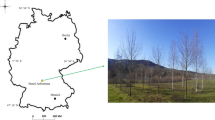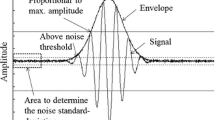Abstract
Key Message
An improved quantification of variations in bark microrelief is presented that uses wavelets on a circular domain from data acquired using the LaserBark™ automated tree measurement system.
Abstract
An important metric of canopy structure, bark microrelief affects both the hydrology and biogeochemistry of forests. Increased bark microrelief leads to reduced stemflow volumes and higher concentrations of stemflow leachates and nutrient-ions. Consequently, an improved representation of bark microrelief would be useful to describe the influence of various tree species on water and solute contributions to the forest floor. Most existing methods to quantify bark microrelief are ‘global’ measures; that is, they provide a single number that represents the overall bark microrelief of the entire perimeter of the tree. To remedy this, wavelet analysis of LaserBark™ automated tree measurement system data is proposed and described to quantify variations in bark microrelief around the perimeter of the tree. This measure describes the spatial differences in bark microrelief and allows representation of trees that exhibit directional variability in bark microrelief due to natural or anthropogenic effects. The results show that wavelet analysis is effective in quantifying both bark microrelief and large-scale tree asymmetry. The radial component highlights changes in the depth of bark microrelief while the tangential component relates to the distance between bark furrows in the bark cross section. Thus, wavelet analysis may be a useful tool for comparing bark structure that varies, for example, within- and between-tree species, at different stages of tree growth, and among trees grown under different environmental conditions.









Similar content being viewed by others
Notes
The derivative of a Gaussian and Paul wavelets also were examined but the Morlet wavelet yielded the best results.
References
Arivazhagan S, Ganesan L (2003) Texture classification using wavelet transform. Pattern Recognit Lett 24:1513–1521
Avci E (2008) Comparison of wavelet families for texture classification by using wavelet packet entropy adaptive network based fuzzy inference system. Appl Soft Comput 8:225–231
Fritz Ö, Brunet J, Caldiz M (2009) Interacting effects of tree characteristics on the occurrence of rare epiphytes in a Swedish beech forest area. Bryologist 112(3):488–505
Frost EE, Levia DF (2013) Hydrologic variation of stemflow yield across co-occurring dominant canopy trees of varying mortality. Ecohydrology. doi:10.1002/eco.1397
Gilman DL, Fuglister FJ, Mitchell JM (1963) On the power spectrum of red noise. J Atmos Sci 20(2):182–184
Grossmann A, Morlet J (1984) Decomposition of Hardy functions into square integrable wavelets of constant shape. SIAM J Math Anal 15(4):723–736
Hauck M, Paul A (2005) Manganese as a site factor for epiphytic lichens. Lichenologist 37:409–423
Hauck M, Hesse V, Runge M (2002) The significance of stemflow chemistry for epiphytic lichen diversity in a dieback-affected spruce forest on Mt. Brocken, northern Germany. Lichenologist 34:415–427
Huang K, Aviyente S (2006) Information-theoretic wavelet packet subband selection for texture classification. Signal Process 86:1410–1420
Hudgins L, Friehe CA, Mayer ME (1993) Wavelet transforms and atmospheric turbulence. Phys Rev Lett 71(20):3279–3282
Kaiser G (1994) A friendly guide to wavelets. Birkhäuser, Basel
Lang GE, Reiners WA, Heier RK (1976) Potential alteration of precipitation chemistry by epiphytic lichens. Oecologia 25:229–241
Levia DF (2002) Nitrate sequestration by corticolous macrolichens during winter precipitation events. Int J Biometeorol 46:60–65
Levia DF, Herwitz SR (2000) Physical properties of stemflow water in relation to leachate dynamics: implications for nutrient cycling. Can J For Res 30:662–666
Levia DF, Herwitz SR (2005) Interspecific variation of bark water storage capacity of three deciduous tree species in relation to stemflow yield and solute flux to forest soils. Catena 64:117–137
Loppi S, Pirintsos SA (2003) Epiphytic lichens as sentinels for heavy metal pollution at forest ecosystems. Environ Pollut 121:327–332
Mendoza B, Garcia-Acosta V, Velasco V, Jauregui E, Diaz-Sandoval R (2007) Frequency and duration of historical droughts from the 16th to the 19th centuries in the Mexican Maya lands, Yucatan Peninsula. Clim Change 83(1–2):151–168
Perrier V, Philipovitch T, Basdevant C (1995) Wavelet spectra compared to Fourier spectra. J Math Phys 36(3):1506–1519
Pike LH (1978) The importance of epiphytic lichens in mineral cycling. Bryologist 81:247–257
Sengur A, Turkoglu I, Ince MC (2007) Wavelet packet neural networks for texture classification. Expert Syst Appl 32:527–533
Torrence C, Compo GP (1998) A practical guide to wavelet analysis. Bull Am Meteorol Soc 79(1):61–78
Torrence C, Webster PJ (1999) Interdecadal changes in the ENSO–monsoon system. J Clim 12(8):2679–2690
Van Stan JT, Levia DF (2010) Inter- and intraspecific variation of stemflow production from Fagus grandifolia Ehrh. (American beech) and Liriodendron tulipifera L. (yellow poplar) in relation to bark microrelief in the eastern United States. Ecohydrology 3(1):11–19
Van Stan JT, Jarvis MT, Levia DF (2010) An automated instrument for the measurement of bark microrelief. IEEE Trans Instrum Meas 59:491–493
Velasco VM, Mendoza B (2008) Assessing the relationship between solar activity and some large scale climatic phenomena. Adv Space Res 42:866–878
Yarlagadda RKR (2010) Analog and digital signals and systems. Springer, New York
Yarranton GA (1967) An instrument for measuring the microrelief of bark. Can J Bot 45:1173–1178
Acknowledgments
Support of the LaserBark’s development was graciously supplied by The Starrett Foundation. We thank the Fair Hill Natural Resource Management Area for their permission to conduct this research on site. Dr. Velasco Herrera acknowledges the support from Grant CONACyT-180148. Helpful comments and suggestions by Dr. Willie Soon (Harvard-Smithsonian), the Communicating Editor, and three anonymous reviewers are greatly appreciated.
Conflict of interest
The authors declare that they have no conflict of interest.
Author information
Authors and Affiliations
Corresponding author
Additional information
Communicated by A.C. Franco.
Rights and permissions
About this article
Cite this article
Legates, D.R., Levia, D.F., Van Stan, J.T. et al. Using wavelet analysis to examine bark microrelief. Trees 28, 413–425 (2014). https://doi.org/10.1007/s00468-013-0959-9
Received:
Revised:
Accepted:
Published:
Issue Date:
DOI: https://doi.org/10.1007/s00468-013-0959-9




